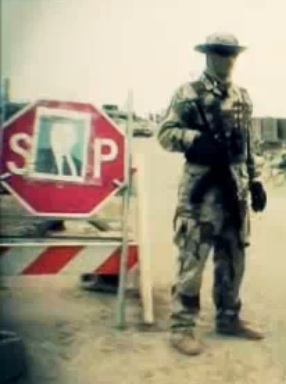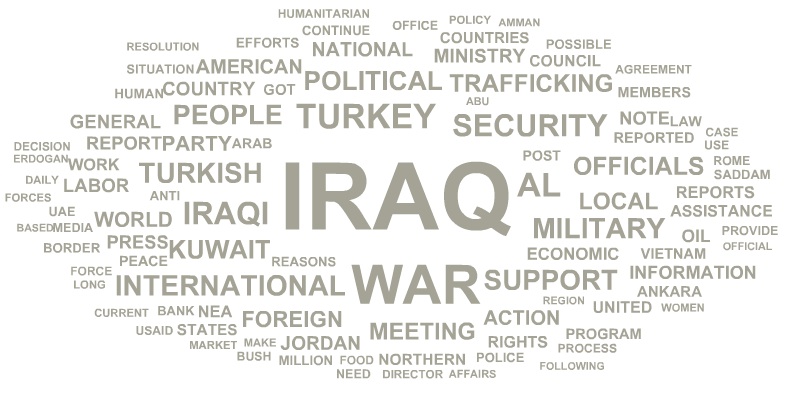 This date, March 19, 2011, marks the beginning of the ninth year of the US war in Iraq. The war, which began in 2003 with a bombing campaign of “shock and awe," has for years been more of an occupation than a war. Despite the fact that many believe the war is over (especially Americans), the US still has 47,000 troops in Iraq and, despite a 2011 withdrawal date, will likely continue to have tens of thousands of soldiers based in Iraq for years to come.
This date, March 19, 2011, marks the beginning of the ninth year of the US war in Iraq. The war, which began in 2003 with a bombing campaign of “shock and awe," has for years been more of an occupation than a war. Despite the fact that many believe the war is over (especially Americans), the US still has 47,000 troops in Iraq and, despite a 2011 withdrawal date, will likely continue to have tens of thousands of soldiers based in Iraq for years to come.
The past year has seen the world learn a great deal about the US war and occupation of Iraq. With the WikiLeaks release of US State Cables, the Iraq War Logs, and a “Collateral Murder” video showing US soldiers firing on journalists and innocent civilians from an Apache helicopter, the criminal nature of the war and occupation has become more evident. To mark the end of eight years of US troops in Iraq and the beginning of a ninth year, it is worth noting the many revelations on Iraq that have become known thanks to WikiLeaks.
On October 22, 2010, 390,000 field reports, which became known as the Iraq War Logs, showed the regular use of abuse, brutality and torture used on Iraqis by Iraqi Police and Iraqi Security Forces. The logs revealed, despite US claims, a tracking of civilian deaths had been going on, and, in fact, 66,000 civilian deaths (15,000 which were previously unknown) had occurred.
At a press conference one day after the release, Phil Shiner of Public Interest Lawyers in the United Kingdom, a firm that has acted on behalf of Iraqis claiming they were tortured or the victim of indiscriminate military attacks, explained how the released evidence could be broken into three key categories: unlawful killings of civilians, indiscriminate attacks or the unjustified use of lethal force against civilians, horrendous abuse and torture of Iraqis by the Iraqi National Guard or the Iraqi Police Service, torture of Iraqis whilst in UK custody (presumably, whilst in the custody of US and other coalition forces custody as well).
Specifically in relation to the Iraqi National Guard or the Iraqi Police Service, Shiner highlighted a fragmented order Frago 242, which the US and the UK appeared to have adopted as a way of excusing them from having to take responsibility for torture or ill-treatment of Iraqis by Iraqi military or security forces. This, according to Shiner, runs "completely contrary to international law" and "it's well known that there's an absolute prohibition on torture" and "it may never be used."
The logs further revealed the existence of a “Wolf Brigade” or “Wolf Battalion.” This brigade was a death squad of Iraqi soldiers that went around terrorizing “insurgents.” It became known for its brutality and was so feared in Iraq that US interrogators would threaten Iraqi detainees with the prospect of being turned over to the squad:
DURING THE INTERROGATION PROCESS THE ___ THREATENED THE SUBJECT DETAINEE THAT HE WOULD NEVER SEE HIS FAMILY AGAIN AND WOULD BE SENT TO THE WOLF BATTALION WHERE HE WOULD BE SUBJECT TO ALL THE PAIN AND AGONY THAT THE WOLF BATTALION IS KNOWN TO EXACT UPON ITS DETAINEES." [December 14, 2005]
The Guardian further detailed the Wolf Brigade or the use of an “El Salvador Option”:
"The Wolf Brigade was created and supported by the US in an attempt to re-employ elements of Saddam Hussein's Republican Guard, this time to terrorise insurgents.
Members typically wore red berets, sunglasses and balaclavas, and drove out on raids in convoys of Toyota Landcruisers. They were accused by Iraqis of beating prisoners, torturing them with electric drills and sometimes executing suspects. The then interior minister in charge of them was alleged to have been a former member of the Shia Badr militia."
Additionally, details in log entries from 2004 and 2005, according to The Guardian, indicated US infantry raids led to the handing over of detainees to the Wolf Brigade for "further questioning" multiple times. And, a New York Times writer concluded, "US soldiers, US advisers, were standing aside and doing nothing."
The logs uncovered reports of detainee abuse and brutality. These incidents were recorded and never investigated further.
" A CF party, including a ___ went to the Ar ___ Police Department iot investigate a statement that was done by an ___. He mentioned that detainees are tortured in prison by IZ Police Officers. Using a hygienic inspection as an excuse, ___ detainees were searched and questioned without IZP attendance. The conclusion taken after this is that drug or medicine users are being tortured specially during dark hours. Methods they are using are to blindfold the detainee and hang them upside down on their feet iot hit them on their foot soles. Also the use of an electrical device is confirmed. This subject ___ with senior IZP Officers iot stop this, also ___ inspections ___. ["A CF party, including a ___ went to the Ar ___ Police Department iot investigate a statement that was done by an ___. He mentioned that detainees are tortured in prison by IZ ___" February 10, 2004]
ON 29MAY05 AN MNF-___ APPROVED JOINT INTERROGATION PROJECT WITH THE IRAQI POLICE IN MOSUL REVEALED EVIDENCE OF PRIOR TORTURE/ABUSE ON 3X LOCAL NATIONALS THAT HAD BEEN CAPTURED APPROX. ___. EXAMINATION OF THE DETAINEES SHOWED LACERATIONS ON WRISTS FROM HANDCUFFS, BRUISING ON THE BACK AND THIGHS, BRUISING ON FACE. DETAINEES ALLEGE THAT THEY WERE BEATEN BY POLICE WITH CABLE ON THE BACK, CHEST AND FACE; HUNG BY THE WRISTS AND FORCED TO CONFESS TO TERRORIST ACTS. ["SUSPECTED DETAINEE ABUSE BY IPS IVO MOSUL: ___ DETAINEES ALLEGE ABUSE", May 29, 2005]
Channel 4 News reported that the Bureau of Investigative Journalism (TBIJ) and Channel 4 Dispatches found "between 2004 and 2009 32,563 civilians were murdered" and that of the numerous unidentified corpses, which coalition forces often found in the Tigris River, "10,871 civilians were shot in the head, 439 were decapitated and up to 164 were recorded as children." The news organization suggested these "murders" were largely a result of "sectarian death squads."
TBIJ and Dispatches also found "over 300 classified reports in the Iraq war logs alleging abuse by coalition forces on Iraqi prisoners after the Abu Ghraib scandal" and that, in the time span covered by the logs, "some 180,000 Iraqis were imprisoned" or appoximately "one in 50 of the adult male population of Iraq" were imprisoned. And, "more than 1,300 individual cases of torture and abuse carried out by Iraqis on Iraqi prisoners at police stations and army bases, which imply that coalition forces either witnessed or reported on themselves" occurred.
Also revealed was more details on how military contractors in Iraq (like Blackwater) had killed civilians with impunity.
As Julian Assange, founder of WikiLeaks said, they showed the “truth that occurred before the war, during the war, and [what has] continued on since the war officially concluded."
On April 6, 2010, WikiLeaks released “Collateral Murder,” a video from the US military showing soldiers targeting and killing civilians in Baghdad. It shows a Reuters journalist and his driver being shot and killed by US soldiers in a helicopter.
It shows a “Good Samaritan,” Saleh Mutashar, driving up in a van and being killed as he tries to save the wounded. His two children are wounded. A US soldier shouts, “Oh yeah, look at that. Right through the windshield! Ha ha!”
Ethan McCord, one of the first soldiers on the scene after the helicopter attack, appears in the video. He saves the two children. His superiors order him to stop saving the wounded. He was deeply bothered by the fact that he was the only one interested in saving lives.
McCord recently appeared in a Panorama documentary. He talked about the shooters in the video being protected and not charged with war crimes, highlighted how the US had covered up the truth of the attack prior to WikiLeaks’ release of the video and juxtaposed that dark reality with the fact that former Pfc. Bradley Manning, alleged to have leaked the video (along with other material) to WikiLeaks, is being held in solitary confinement and abused and humiliated in prison. And, McCord said after the attack he could no longer justify being a US soldier in Iraq.

Aftenposten, a Norwegian newspaper that has partnered with WikiLeaks to release US State Embassy cables, shows how Iraq was the focus of cables in March 2003.
As for Cablegate, the release of US State Embassy Cables that WikiLeaks began over one hundred days ago in the final days of November 2010, there have been some revelations but much more will likely become known. From 2003 to at least 2006, Iraq was one of the most talked about topics by diplomats.
So far, what has become known from cables includes the following:
-The Ministry of Defence in the UK told the US it “put measures in place” to protect America during a Chilcot inquiry into the war.
-Iraqi security firms have been suspected it might try to put America’s own citizens on trial for war crimes committed in Iraq.
-Spanish officials worked with the US to prevent the arrests of soldiers that were likely involved in the killing of Spanish television cameraman Jose Couso.
Now, the US supports and helps reinforce Prime Minister Nouri Maliki's repression of protests in Iraq, as citizens inspired by Egyptians and Tunisians have taken to the streets to demand greater economic justice, human rights and freedom in the past weeks.
Americans opposed to the continuing presence of US troops in Iraq will protest across the country today. As usual, US corporate media will ignore the protests. Few Americans will realize there are people who are willing to take action, that people are outraged by what the US continues to perpetrate in Iraq (unless they read independent media or are following the protests on Twitter or have friends and family that protest).
People like Daniel Ellsberg, who has been a key supporter of Manning and WikiLeaks, will risk arrest in Washington, D.C. because, as WikiLeaks has shown, there are crimes being committed by the US that many believe should be stopped.
*Photo a screen shot from Al Jazeera English's special "The Secret Iraq Files."
Theme by Danetsoft and Danang Probo Sayekti inspired by Maksimer